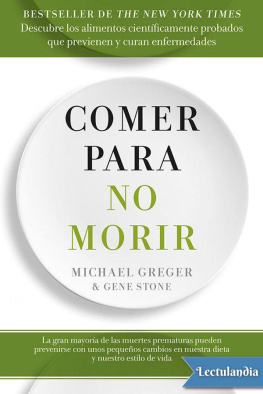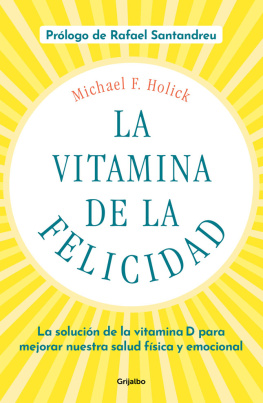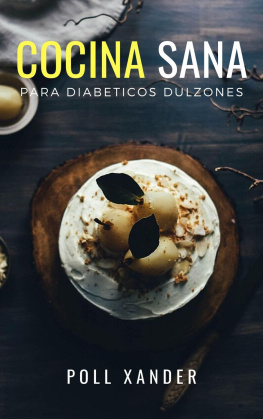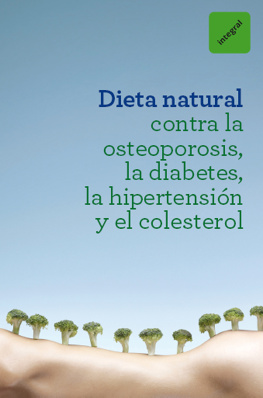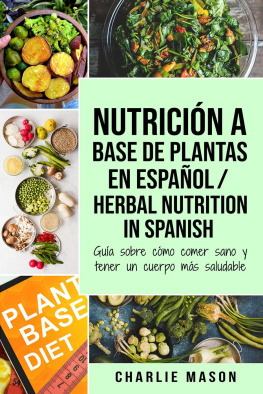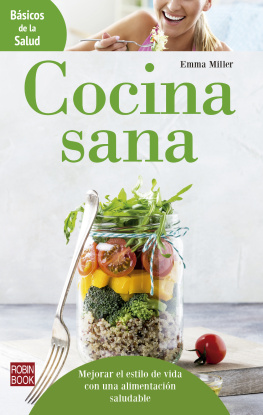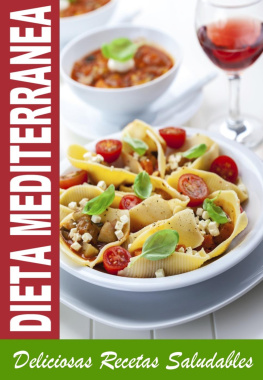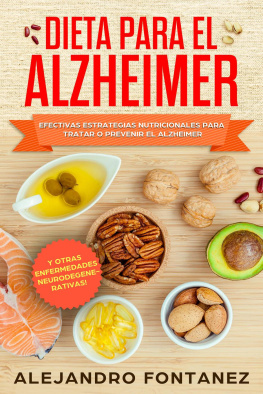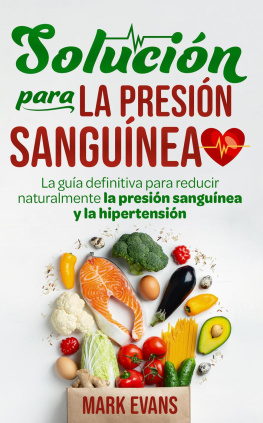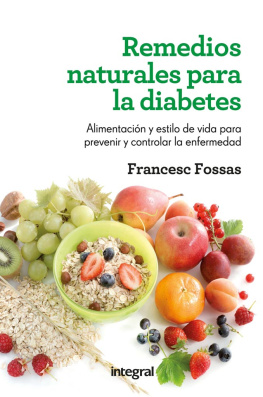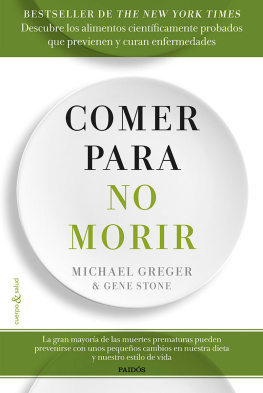La gran mayoría de muertes prematuras podrían prevenirse con tan solo llevar a cabo sencillos cambios en la dieta y en el estilo de vida. En Comer para no morir, el doctor Michael Greger, experto en nutrición y médico de fama mundial, analiza las quince primeras causas de muerte (enfermedades cardiovasculares, distintos tipos de cáncer, diabetes, enfermedad de Parkinson o hipertensión arterial, entre otras) y explica cómo algunos cambios en la alimentación y el estilo de vida pueden ser más eficaces que las pastillas u otros tratamientos farmacológicos y quirúrgicos, y de este modo vivir una vida más saludable.

Michael Greger y Gene Stone
Comer para no morir
ePub r1.0
Titivillus 19.08.17
Título original: How Not to Die
Michael Greger y Gene Stone, 2015
Traducción: Montserrat Asensio Fernández
Primera edición en libro electrónico: mayo 2016
Editor digital: Titivillus
ePub base r1.2

A mi abuela, Frances Greger

GENE STONE es periodista y escritor. Ha puesto en práctica todo aquello que escribe, de manera que su conocimiento no es sólo teórico, sino empírico. Como paciente sano, se ha expuesto a todo tipo de pruebas y chequeos para poder extraer conclusiones. Ha probado con acupuntura, reiki, reflexología, distintas terapias (freudianas, jungianas), métodos New Age, etc. Licenciado por Stanford y Harvard, Gene Stone ha sido guionista, productor de televisión y editor de libros, revistas y periódicos para empresas como Los Angeles Times, California, Esquire, Harcourt Brace, y Simon & Schuster.
También ha escrito más de treinta libros para otras personas, entre las que se encuentran Stephen Hawking, Tim Sanders (un alto ejecutivo de Yahoo!), Gail Evans (vicepresidente ejecutivo de CNN), etc., y muchos de ellos han estado en las listas de más vendidos. Entre los que ha escrito con su nombre está el bestseller The Bush Survival Bible (La Biblia de supervivencia en la era Bush) y The Watch (El libro definitivo sobre el reloj de pulsera). Vive en Nueva York.
VERDURAS CRUCÍFERAS
[2028] Lenzi, M., Fimognari, C., Hrelia, P., «Sulforaphane as a promising molecule for fighting cancer», en Cancer Treat Res., 159, 2014, pp. 207–223.
[2029] Tarozzi, A., Angeloni, C., Malaguti, M., Morroni, F., Hrelia, S., Hrelia, P., «Sulforaphane as a potential protective phytochemical against neurodegenerative diseases», en Oxid Med Cell Longev., 2013, 2013, p. 415078.
[2030] Liu, H., Smith, A. J., Lott, M. C., et al., «Sulforaphane can protect lens cells against oxidative stress: implications for cataract prevention», en Invest Ophthalmol Vis Sci., 54(8), 2013, pp. 5236–5248.
[2031] Heber, D., Li, Z., Garcia-Lloret, M., et al., «Sulforaphane-rich broccoli sprout extract attenuates nasal allergic response to diesel exhaust particles», en Food Funct., 5(1), 2014, pp. 35–41.
[2032] Bahadoran, Z., Mirmiran, P., Azizi, F., «Potential efficacy of broccoli sprouts as a unique supplement for management of type 2 diabetes and its complications», en J Med Food, 16(5), 2013, pp. 375–382.
[2033] Matusheski, N. V., Juvik, J. A., Jeffery, E. H., «Heating decreases epithiospecifi er protein activity and increases sulforaphane formation in broccoli», en Phytochemistry, 65(9), 2004, pp. 1273–1281.
[2034] Singh, K., Connors, S. L., Macklin, E. A., et al., «Sulforaphane treatment of autism spectrum disorder (ASD)», en Proc Natl Acad Sci USA, 111(43), 2014, pp. 15550–15555.
[2035] Vermeulen, M., Klöpping-Ketelaars, I. W., Van den Berg, R., Vaes, W. H., «Bioavailability and kinetics of sulforaphane in humans after consumption of cooked versus raw broccoli», en J Agric Food Chem., 56(22), 2008, pp. 10505–10509.
[2036] Ferrarini, L., Pellegrini, N., Mazzeo, T., et al., «Anti-proliferative activity and chemoprotective effects towards DNA oxidative damage of fresh and cooked Brassicaceae», en Br J Nutr., 107(9), 2012, pp. 1324–1332.
[2037] Collins, P. J., Horowitz, M., Chatterton, B. E., «Proximal, distal and total stomach emptying of a digestible solid meal in normal subjects», en Br J Radiol., 61(721), 1988, pp. 12–18.
[2038] Dosz, E. B., Jeffery, E. H., «Modifying the processing and handling of frozen broccoli for increased sulforaphane formation», en J Food Sci., 78(9), 2013, pp. H1459–H1463.
[2039] Olsen, H., Grimmer, S., Aaby, K., Saha, S., Borge, G. I., «Antiproliferative effects of fresh and thermal processed green and red cultivars of curly kale (Brassica oleracea L. convar. acephala var. sabellica)», en J Agric Food Chem., 60(30), 2012, pp. 7375–7383.
[2040] Dosz, E. B., Jeffery, E. H., «Commercially produced frozen broccoli lacks the ability to form sulforaphane», en Journal of Functional Foods, (5)2, 2013, pp. 987–990.
[2041] Ghawi, S. K., Methven, L., Niranjan, K., «The potential to intensify sulforaphane formation in cooked broccoli (Brassica oleracea var. italica) using mustard seeds (Sinapis alba)», en Food Chem., 138(2–3), 2013, pp. 1734–1741.
[2042] Dosz, E. B., Jeffery, E. H., «Modifying the processing and handling of frozen broccoli for increased sulforaphane formation», en J Food Sci., 78(9), 2013, pp. H1459–H1463.
[2043] Nolan, C., «Kale is a noun», en <
[2044] U.S. Department of Agriculture Economic Research Service, «Cabbage—average retail price per pound and per cup equivalent, 2013», en <
[2045] U.S. Department of Agriculture, «Oxygen Radical Absorbance Capacity (ORAC) of Selected Foods—2007», en <
[2046] U.S. Department of Agriculture Economic Research Service, «Cabbage—average retail price per pound and per cup equivalent, 2013», en <
[2047] Gu, Y., Guo, Q., Zhang, L., Chen, Z., Han, Y., Gu, Z., «Physiological and biochemical metabolism of germinating broccoli seeds and sprouts», en J Agric Food Chem., 60(1), 2012, pp. 209–213.
[2048] Clarke, J. D., Hsu, A., Riedl, K., et al., «Bioavailability and inter-conversion of sulforaphane and erucin in human subjects consuming broccoli sprouts or broccoli supplement in a cross-over study design», en Pharmacol Res., 64(5), 2011, pp. 456–463.
[2049] Shapiro, T. A., Fahey, J. W., Dinkova-Kostova, A. T., et al., «Safety, tolerance, and metabolism of broccoli sprout glucosinolates and isothiocyanates: a clinical phase I study», en Nutr Cancer, 55(1), 2006, pp. 53–62.
[2050] Sestili, P., Paolillo, M., Lenzi, M., et al., «Sulforaphane induces DNA single strand breaks in cultured human cells», en Mutat Res., 689(1–2), 2010, pp. 65–73.
VERDURAS DE HOJA VERDE
[2051] Kwak, C. S., Moon, S. C., Lee, M. S., «Antioxidant, antimutagenic, and antitumor effects of pine needles (Pinus densiflora)», en Nutr Cancer, 56(2), 2006, pp. 162–171.
[2052] Grivetti, L. E., Corlett, J. L., Gordon, B. M., Lockett, G. T., «Food in American history: Part 10. Greens: Part 1. Vegetable greens in a historical context», en Nutr Today, 42(2), 2008, pp. 88–94.

